Upstream BR321 Single Door Refrigerator
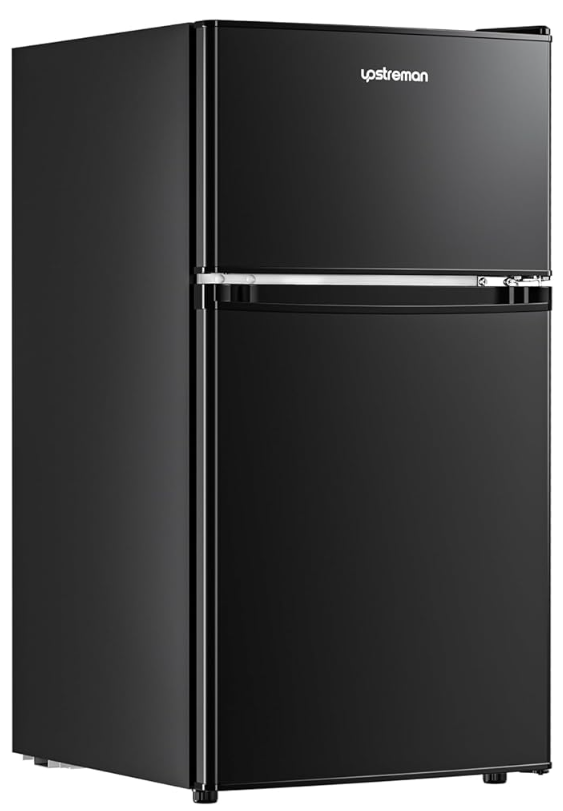
REFRIGERATOR SAFETY
Your safety and the safety of others are very important. We have provided many important sad ty messages on his manual to your appliance. Always read and obey all safety messages.
![]() This is the Safety Alert Symbol. This symbol alerts you to potential hazards that can kill or injure you and others. All safety messages will follow the Safety Alert Symbol and either the words” DANGER”, “WARNING” or “CAUTION”.
This is the Safety Alert Symbol. This symbol alerts you to potential hazards that can kill or injure you and others. All safety messages will follow the Safety Alert Symbol and either the words” DANGER”, “WARNING” or “CAUTION”.
- DANGER Danger means that failure to heed this safety statement may result in severe personal injury or death.
- WARNING Warning means that failure to heed this safety statement may result in extensive product damage, serious personal injury, or death.
- CAUTION Caution means that failure to heed this safety statement may result in minor or moderate personal injury, or property or equipment damage.
All safety messages will alert you to know what potential hazard is, tell you how to reduce the chance of injury, and let you know what can happen if the instructions are not followed.
IMPORTANT SAFEGUARDS
Before the refrigerator is used, it must be properly positioned and installed as described in this manual, so read the manual carefully. To reduce the risk of fire, electrical shock, or injury when using the refrigerator, follow basic precautions, including the following:
DANGER
- Plug into a grounded 3-prong outlet, do not remove the grounding prong, and do not use an adapter or extension cord.
- Replace all panels before operating.
- It is recommended to use a separate circuit to serve your refrigerator. Use receptacles that cannot be turned off by a switch or pull chain.
- Never clean refrigerator parts with flammable fluids or store or use gasoline or other flammable vapors and liquids in the vicinity of this or any other appliance, because the fumes can create a fire hazard or explosion.
- Before proceeding with cleaning and maintenance operations, make sure the power line of the unit is disconnected.
- Do not connect or disconnect the electric plug when your hands are wet.
- Unplug the refrigerator or disconnect the power before cleaning or servicing. Failure to do so can result in electrical shock or death.
- Do not attempt to repair or replace any part of your refrigerator unless it is specifically recommended in this manual. All other servicing should be referred to a qualified technician.
WARNING
FOLLOW THE WARNING CALLOUTS BELOW ONLY WHEN APPLICABLE TO YOUR MODEL
- Use two or more people to move and install refrigerators. Failure to do so can result in injury.
- To ensure proper ventilation for your refrigerator, the front of the unit must be completely unobstructed. Choose a well-ventilated area with temperatures above 60ºF (16°C) and below 90°F (32°C). This unit must be installed in an area protected from the elements, such as wind, rain, water spray, or drips.
- The refrigerator should not be located next to ovens, grills, or other sources of high heat.
PARTS & FEATURES
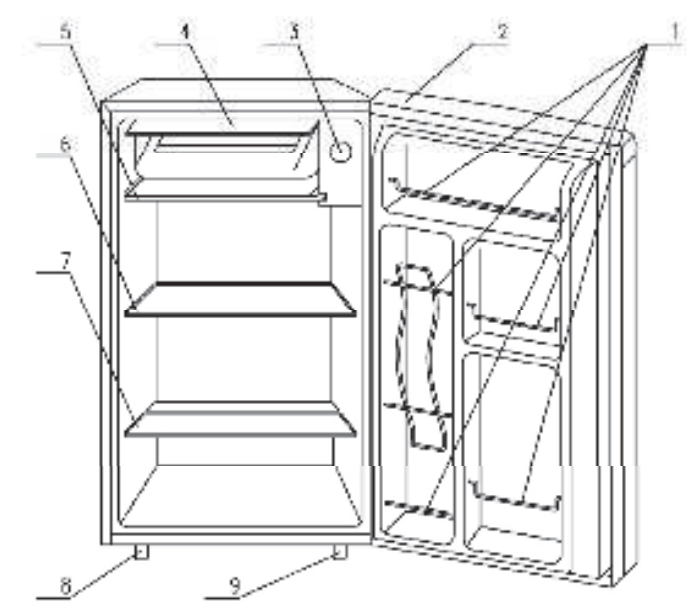
- Door bins
- Door
- Thermostat
- Chiller compartment door
- Drip tray
- Removable shelf (Big)
- Removable shelf (Small)
- Leveling leg
- Front foot
IMPORTANT SAFETY INSTRUCTIONS
WARNING To reduce the risk of fire, electrical shock, or injury when using your appliance, follow these basic precautions:
- Read all instructions before using the refrigerator freezer.
- DANGER or WARNING: Risk of child entrapment.
- Before you throw away your old refrigerator freezer: Take off the doors. Leave the shelves in place so that children may not easily climb inside.
- Never allow children to operate, play with, or crawl inside the refrigerator freezer.
- Never clean refrigerator-freezer parts with flammable fluids. The fumes can create a fire hazard or explosion.
- Do not store or use gasoline or any other flammable vapors and liquids in the vicinity of this or any other refrigerator freezer. The fumes can create a fire hazard or explosion.
INSTALLATION INSTRUCTIONS
Before Using Your Unit
- • Remove the exterior and interior packing.
- • Check to be sure you have all of the following parts:
- 1 Water Drip Tray
- 1 Ice Cube Tray
- 1 Instruction Manual
- Before connecting the unit to the power source, let it stand upright for approximately 2 hours. This will reduce the possibility of a malfunction in the cooling system from handling during transportation.
- Clean the interior surface with lukewarm water using a soft cloth.
Installing Your Unit
- This appliance is designed to be free-standing only, and should not be recessed or built-in.
- Place your unit on a floor that is strong enough to support the unit when it is fully loaded. To level your unit, adjust the leveling legs at the bottom of the unit.
- Allow 5 inches of space between the back and sides of the unit, which allows the proper air circulation to cool the compressor and condenser.
- Locate the unit away from direct sunlight and sources of heat (stove, heater, radiator, etc.). Direct sunlight may affect the acrylic coating and heat sources may increase electrical consumption. Extreme cold ambient temperatures may also cause the unit not to perform properly.
- Avoid locating the unit in moist areas. Plug the unit into an exclusive, properly installed-grounded wall outlet. Do not under any circumstances cut or remove the third (ground) prong from the power cord. Any questions concerning power and/or grounding should be directed toward a certified electrician or an authorized C.I. Service Dept. (Canada) or C.I. Service D Dept. (USA)
- After plugging the appliance into a wall outlet, allow the unit to cool down for 2-3 hours before placing food in the refrigerator and freezer compartments.
Electrical Connection
Warning
Improper use of the grounded plug can result in the risk of electrical shock. If the power cord is damaged, have it replaced by an authorized C.I. Service Dept. (Canada) or C.I. Service D Dept. (USA) This unit should be properly grounded for your safety. The power cord of this unit is equipped with a three-prong plug which mates with standard three-prong wall outlets to minimize the possibility of electrical shock.
Do not under any circumstances cut or remove the third ground prong from the power cord supplied. For personal safety, this appliance must be properly grounded. This unit requires a standard 115/120 Volt AC ~/60Hz electrical outlet with three-prong ground. Have the wall outlet and circuit checked by a qualified electrician to make sure the outlet is properly grounded. When a standard 2-prong wall outlet is encountered, it is your responsibility and obligation to have it replaced with a properly grounded 3-prong wall outlet.
The cord should be secured behind the unit and not left exposed or dangling to prevent accidental injury. The unit should always be plugged into its own individual electrical outlet which has a voltage rating that matches the rating label on the appliance. This provides the best performance and also prevents overloading house wiring circuits that could cause a fire hazard from overheating. Never unplug the unit by pulling the power cord. Always grip the plug firmly and pull straight out from the receptacle. Repair or replace immediately all power cords that have become frayed or otherwise damaged. Do not use a cord that shows cracks or abrasion damage along its length or at either end. When moving the unit, be careful not to damage the power cord.
Extension Cord
Because of potential safety hazards under certain conditions, it is strongly recommended that you do not use an extension cord with this unit. However, if you must use an extension cord it is absolutely necessary that it be a UL/CUL-Listed, 3-wire grounding type appliance extension cord having a grounding type plug and outlet and that the electrical rating of the cord is 115 volts and at least 10 amperes.
SURGE PROTECTOR
Most electrical appliances use a series of electric control boards to operate. If you have any questions regarding the type and size of surge protector needed contact a licensed electrician in your area. Damages due to power surges are not considered a manufacturer-covered defect and will void your product warranty.
Reversing the Door Swing of Your Appliance
This appliance has the capability of the door opening from either the left or right side. The unit is delivered to you with the door opening from the left side. The following refrigerator pictures are for your reference only.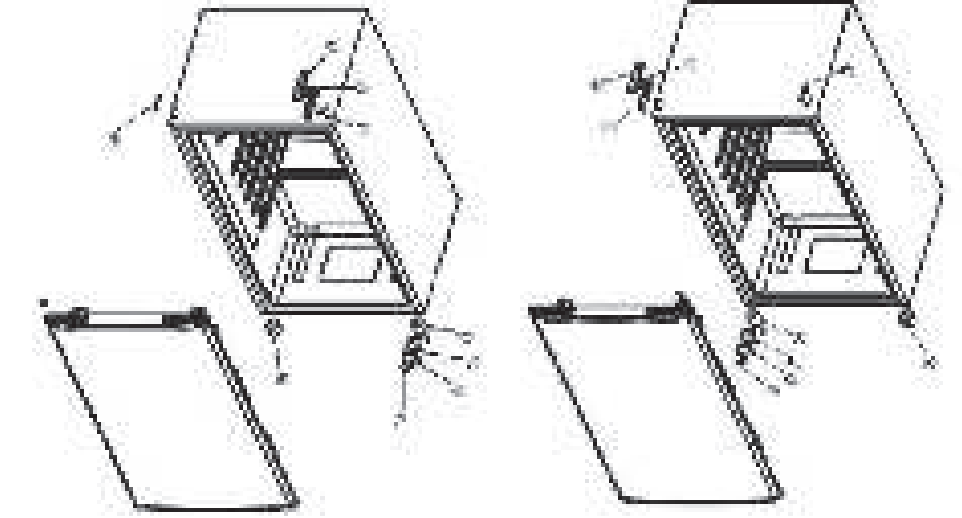
OPERATING YOUR UNIT
Setting the Temperature Control
- Your unit has only one control for regulating the temperature in the compartment. The temperature control is located on the upper right-hand side of the compartment.
- The first time you turn the unit on, set the temperature control to “5.”
- The range of the temperature control is from position “O” to “5”. After 24 to 48 hours, adjust the temperature control to the setting that best suits your needs. The setting of “3” should be appropriate for home or office use.
- To turn the appliance off, turn the temperature control to “O”.
NOTE:
- Turning the temperature control to the “O” position stops the cooling cycle but does not shut off the power to the unit.
- If the unit is unplugged, has lost power, or is turned off, you must wait 3 to 5 minutes before restarting the unit. If you attempt to restart before this time delay, the unit will not start.
Using Your Ice Cube Tray
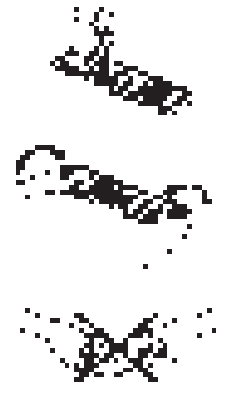 The recommended thermostat setting for ice-making is position 5.
The recommended thermostat setting for ice-making is position 5.- Fill the ice cube tray (two-thirds of it) with cold water or with any liquid suitable for freezing and place the tray on the bottom of the chiller compartment to freeze properly.
- Dry the tray, otherwise, it may stick to the bottom of the chiller.
- The best method to get ice cubes out of the tray is to hold the tray under cold tap water for a second.
- To eject the ice cubes from the tray, place them over the ice bucket and twist slightly.
The Chiller Compartment
- This chiller compartment is not a true freezer and may not keep ice cream or items.
- A colder setting may be used for these items, but other items in the refrigerator may also be affected.
- The chiller door is susceptible to breaking due to excessive ice buildup. This part is not covered under your warranty. Be sure to defrost when the ice reaches 1/4 inch thick.
CARE AND MAINTENANCE
Defrosting Your Unit
- Defrost the unit when the frost accumulated on the evaporator is about 5mm (1/5 inch) thick. Set the thermostat dial to the “O” position.
- Remove frozen or perishable foods from the appliance and place it in a cooler to protect the food.
- During the defrost cycle, the ice melts into the water collection tray.
- To remove the water, either remove the water collection tray and/or place a collection container under the tray.
- Dry the water collection tray and place it back under the appliance compartment. Defrosting usually takes a few hours. After defrosting, return the thermostat dial to the desired position. To defrost quickly remove all foods from the unit and leave the door open. Never use a knife or other metal instrument to scrape ice/frost from the evaporator.
Cleaning Your Unit
- Turn the temperature control to “O”, unplug the unit, and remove the food, shelves, and trays.
- Wash the inside surfaces with warm water and baking soda solution. The solution should be about 2 tablespoons of baking soda to a quart of water.
- Wash the shelves and trays with a mild detergent solution.
- The outside of the unit should be cleaned with mild detergent and warm water.
- Wring excess water out of the sponge or cloth before cleaning the area of the controls, or any electrical parts.
- Wash the outside cabinet with warm water and mild liquid detergent. Rinse well and wipe dry with a clean soft cloth.
CAUTION: Failure to unplug the unit could result in electrical shock or personal injury.
CAUTION
Do not use boiling water because it may damage the plastic parts. In addition, never use a sharp or metallic instrument to remove frost as it may damage the cooling coils and will void the warranty. We recommend using a plastic scraper.
- Use a sponge or towel to pick up the melting ice off the unit floor.
- Remove the frozen food from the chiller compartment and place it in a cooler to protect the food.
Power Failure
Most power failures are corrected within a few hours and should not affect the temperature of your unit if you minimize the number of times the door is opened. If the power is going to be off for a longer period of time, you need to take the proper steps to protect your food.
Vacation Time
- Short vacations: Leave the unit operating during vacations of less than three weeks.
- Long vacations: If the appliance will not be used for several months, remove all food and unplug the power cord. Clean and dry the interior thoroughly. To prevent odor and mold growth, leave the door open slightly: blocking it open if necessary.
Moving Your Unit
- Remove all the food.
- Securely tape down all loose items inside your unit.
- Turn the leveling screws up to the base to avoid damage.
- Tape the door shut.
- Be sure the unit stays secure in an upright position during transportation. Also, protect the outside of the unit with a blanket or similar item.
Energy Saving Tips
- The unit should be located in the coolest area of the room, away from heat-producing appliances, and out of direct sunlight.
- Let hot foods cool to room temperature before placing them in the unit. Overloading the unit forces the compressor to run longer.
- Be sure to wrap foods properly, and wipe containers dry before placing them in the unit. This cuts down on frost build-up inside the unit.
- Unit storage bins should not be lined with aluminum foil, wax paper, or paper toweling. Liners interfere with cold air circulation, making the unit less efficient. Organize and label food to reduce door openings and extended searches. Remove as many items as needed at one time, and close the door as soon as possible.
PROBLEMS WITH YOUR UNIT
You can solve many common unit problems easily, saving you the cost of a possible service call. Try the suggestions below to see if you can solve the problem before calling the servicer.
TROUBLESHOOTING GUIDE
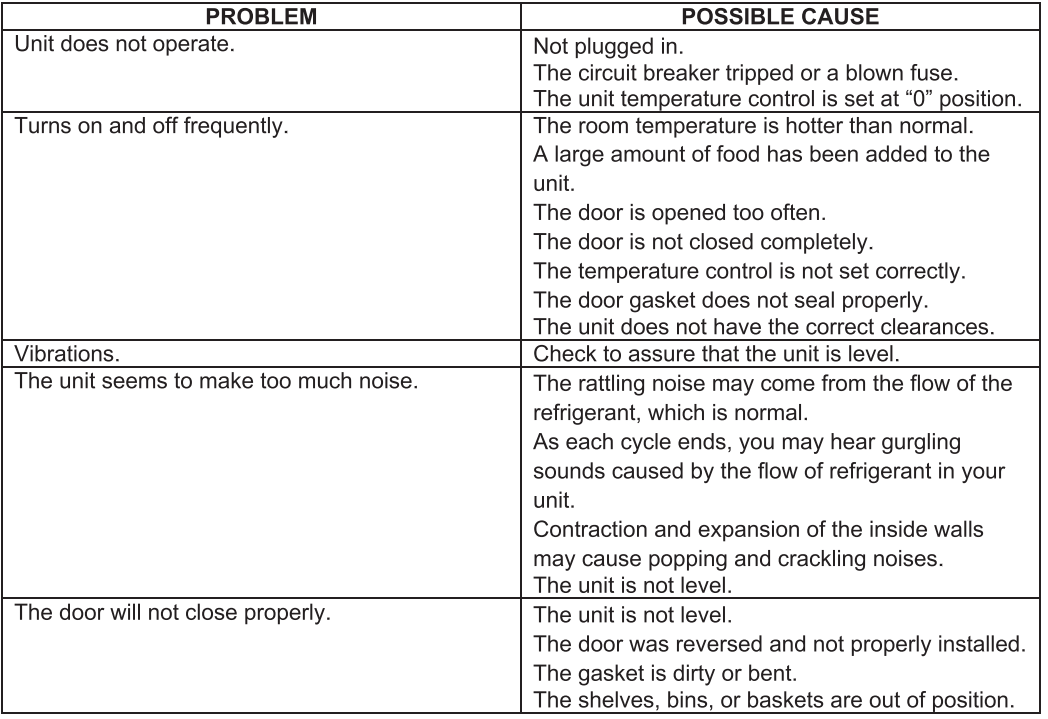
WIRING DIAGRAM
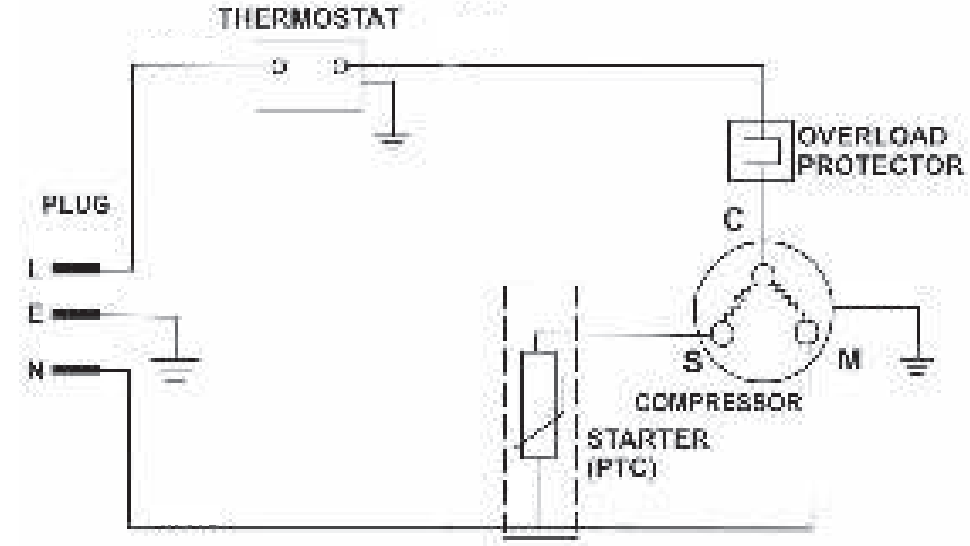
- +1 516-896-6611 Mon-Fri 9AM-5ET
- support@upstreman-home.com
- Shenzhen Lanbiaoyi Technology Co., LTD.
- Room 1438F, Anjier Building, No.52 Bagua 4th Street, Yuanling Ave, Futian District, Shenzhen, China, 518000


